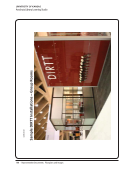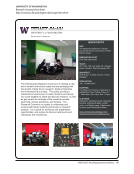SPEC Kit 327: Reconfiguring Service Delivery · 55
Identification by users of most highly valued services. Implementation of new technological solutions to user need, e.g.,
specialized discovery tools, RSS feeds, e-learning environments. Implementation of “embedded librarian” approach
emphasizing placement of library expertise “in the flow” of teaching and research in the liaison program.
Improved aesthetics, improved service flow for both areas, improved service for patrons as we were able to split
checkout areas.
Improved utilization of staff. Improved space for users. Increased accessibility to and availability for some materials (e.g.,
revised policy allowing music CDs to circulate now).
Increased access to electronic health sciences content. Improved collaborations with college of medicine. Improved
student understanding of main library services and resources.
Increased visibility and use of services and spaces for graduate students. Improved spaces and technology for
collaboration among undergraduates and between TAs and undergraduates. More community visibility: demands for
use of space for university conferences, symposia, colloquia, and poster sessions.
Increased visibility of media collection leading to greater access. Service point is on the floor with circulation and
reference allowing for increased service support for media. Greater awareness among collection development librarians
to address new opportunities for hosted streaming.
Interdisciplinary knowledge increased, staff recognized the expertise of others, discipline-specific silos were diminished.
Users benefited because service hours were maintained/extended and users spent less time finding the service desk.
The reconfiguration freed up more time for librarians to provide other priority services, such as teaching, outreach,
collection development, advanced reference, consultation in offices, etc.
Less confusion for users about where to direct requests. Less confusion for Reference Department members about their
role in monitoring the service point. Greater confidence that users are getting reliable and consistent information in
response to their requests.
Librarian embedded in facility for convenient face-to-face consultations/interactions. Additional business librarian will
help handle growing demand for general support and instruction in business programs throughout the university.
Librarians able to provide individualized services to users.
Made patrons more aware of the Learning Commons services. Saved staff and financial resources.
Major benefit is users have knowledgeable staff longer hours who can answer question that come up. Users also
benefit from system that refers question to most appropriate answerer and likely quickest responder. Staff benefit both
from cross training (strategic use of staff expertise) and cooperative understanding of roles across departments.
Major patron services are now all available on one floor during all of the hours that the library is open. The majority
of staff in Access Services are now adjacent to one another and can cooperate more fully. Over time I believe that we
will realize some savings in staff time (once the microform/media/and music monument materials and services are
addressed).
More economical service provision. Service provided by more highly qualified staff. Service point located in a more
visible and convenient location for users.
More free time for librarians. Users directed to main service desk.
More open space on first floor. Easier to direct patrons to Reference or Circulation as required.
Identification by users of most highly valued services. Implementation of new technological solutions to user need, e.g.,
specialized discovery tools, RSS feeds, e-learning environments. Implementation of “embedded librarian” approach
emphasizing placement of library expertise “in the flow” of teaching and research in the liaison program.
Improved aesthetics, improved service flow for both areas, improved service for patrons as we were able to split
checkout areas.
Improved utilization of staff. Improved space for users. Increased accessibility to and availability for some materials (e.g.,
revised policy allowing music CDs to circulate now).
Increased access to electronic health sciences content. Improved collaborations with college of medicine. Improved
student understanding of main library services and resources.
Increased visibility and use of services and spaces for graduate students. Improved spaces and technology for
collaboration among undergraduates and between TAs and undergraduates. More community visibility: demands for
use of space for university conferences, symposia, colloquia, and poster sessions.
Increased visibility of media collection leading to greater access. Service point is on the floor with circulation and
reference allowing for increased service support for media. Greater awareness among collection development librarians
to address new opportunities for hosted streaming.
Interdisciplinary knowledge increased, staff recognized the expertise of others, discipline-specific silos were diminished.
Users benefited because service hours were maintained/extended and users spent less time finding the service desk.
The reconfiguration freed up more time for librarians to provide other priority services, such as teaching, outreach,
collection development, advanced reference, consultation in offices, etc.
Less confusion for users about where to direct requests. Less confusion for Reference Department members about their
role in monitoring the service point. Greater confidence that users are getting reliable and consistent information in
response to their requests.
Librarian embedded in facility for convenient face-to-face consultations/interactions. Additional business librarian will
help handle growing demand for general support and instruction in business programs throughout the university.
Librarians able to provide individualized services to users.
Made patrons more aware of the Learning Commons services. Saved staff and financial resources.
Major benefit is users have knowledgeable staff longer hours who can answer question that come up. Users also
benefit from system that refers question to most appropriate answerer and likely quickest responder. Staff benefit both
from cross training (strategic use of staff expertise) and cooperative understanding of roles across departments.
Major patron services are now all available on one floor during all of the hours that the library is open. The majority
of staff in Access Services are now adjacent to one another and can cooperate more fully. Over time I believe that we
will realize some savings in staff time (once the microform/media/and music monument materials and services are
addressed).
More economical service provision. Service provided by more highly qualified staff. Service point located in a more
visible and convenient location for users.
More free time for librarians. Users directed to main service desk.
More open space on first floor. Easier to direct patrons to Reference or Circulation as required.






















































































































































































































